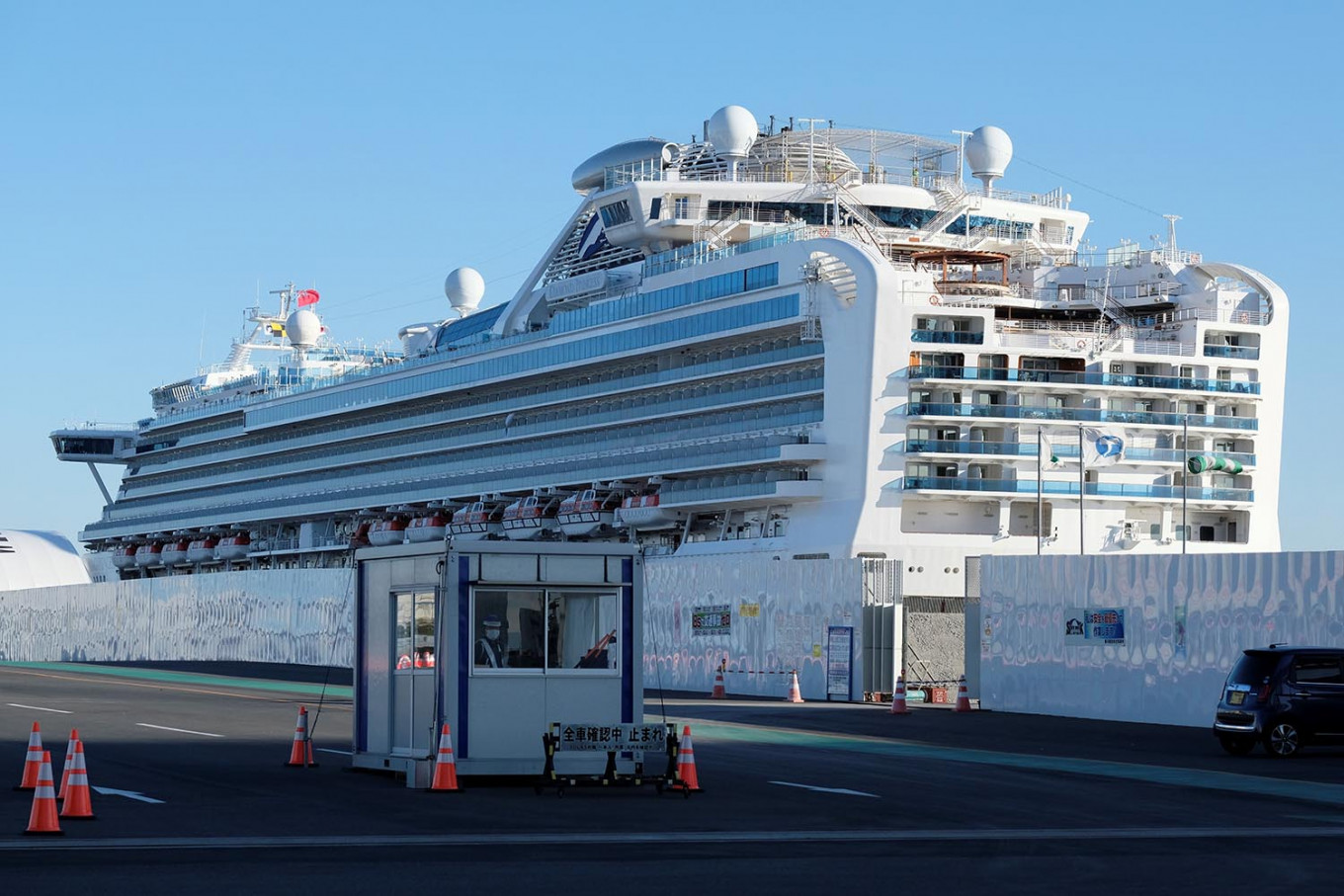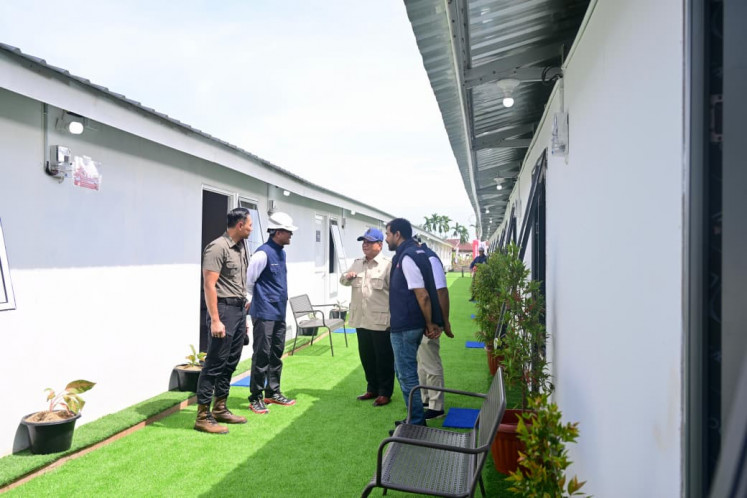Popular Reads
Top Results
Can't find what you're looking for?
View all search resultsPopular Reads
Top Results
Can't find what you're looking for?
View all search resultsCruise control? Securitizing luxury cruise ships in times of coronavirus
The situation onboard the Diamond Princess moored at the Yokohama docks reveals a less efficient story. Expert medical teams from Japan’s hospitals and health ministry came either too little or too late.
Change text size
Gift Premium Articles
to Anyone
O
n Feb. 3, the 116,000 ton luxury cruise liner Diamond Princess made history by becoming the first and biggest floating cluster of novel coronavirus disease (COVID-19) patients in the world. Amid predictions by industry watchers that the US$45 billion cruise industry will shed more than its current 10 to 16 percent share losses in the first two months of 2020, certain useful security lessons are being offered by the Diamond Princess saga, along with its sister liner, the MS Westerdam. What has played out despite the tragedies aboard both vessels is the securitization of ocean-going tourist ships and their passengers. We call this securitization because the very platform for holidaymaking is also a convenient temporary solution for any pandemic in its incipient stages. Securitization, according to political scientists, is the act of constituting a new field of political concern and correspondingly, legitimizing remedial measures at the same time.
The luxury ocean liners become a home away from home for their passengers by providing for every material need and much more. Additionally, not unlike a hospital, living quarters are provided for passengers and crew according to family size, traveling needs, economic status and maritime operational requirements. Ideally, if diseases carried by the passengers are not spread through airborne transmission over large distances, keeping suspected disease carriers offshore is not a far-fetched idea. It may even be a practical one pending medical advances into an unfolding outbreak such as the COVID-19 outbreak.
Of course, the situation onboard the Diamond Princess moored at the Yokohama docks reveals a less efficient story. Expert medical teams from Japan’s hospitals and health ministry came either too little or too late. Reports by major newspapers’ investigative reporters, blogs and social media accounts maintained by those onboard also draw back the curtain on the many missteps by the crew and hospitality staff. Instructions to confine passengers to their cabins were issued in confusing order. Buffet lines and entertainment venues were kept open to passengers without provisioning for temperature checks and assorted onsite medical screening.
The crew did not appear to take the pre-docking warnings that a single passenger who disembarked at Hong Kong nine days earlier had later tested positive for COVID-19. At that point, they could have instituted tight quarantine measures that might well have curbed the contagion significantly among those onboard some 10 days later. As passengers mingled in the mode of the carefree tourist having paid for a vacation of a lifetime, contamination points multiplied exponentially.
The same deficiency in sanitization and preemptive isolation characterized crew quarters, contributing toward infecting ship crew. Tragically, what might have been a constructively applied quarantine vessel escalated into the incubation quarters for a contagious disease.
Tourists as disease carriers are of course not new, nor evitable. The usual tourist routine onboard comprises significant communal time in theaters, clubs, fitness facilities, swimming pools and casinos. The air-conditioning of most of these venues usually abets the spread of viruses that mostly thrive on enclosed cool surfaces. Regular cleaning may not clear communal spaces of lingering viruses especially if they are not sufficiently exposed to sunlight – the ultimate disinfectant. Of course, this contamination prospect applies equally to air-conditioned offices in skyscrapers. But on seagoing vessels the potential for infection is much higher.
Cruise ships, as well as ocean crossing merchant vessels, have been known to experience recurring outbreaks of gastrointestinal viruses and Legionnaires’ disease as well. Although these are nowhere as lethal as COVID-19, gastrointestinal diseases stem as easily from passengers’ highly varied hygiene habits as from poor food handling and sanitation maintenance onboard. That said, there is also nothing to prevent already ill passengers from taking a cruise that they have likely paid for in advance. The flu-like Legionnaires’ disease is also a product of mostly poor maintenance of toilet water faucets and air-conditioning ducts. But blaming shoddy onboard plumbing maintenance is not necessarily the final prognosis. Cruise operators must surely also be asked if their maintenance schedules have had their corners cut to fit the profitable scope of mass-market tourism. Turning a ship around between ports of call in the shortest time possible can mean eliminating thorough cleaning procedures in favor of quick fixes.
The cases of the Diamond Princess and MS Westerdam under COVID-19 conditions ironically draw attention to the muddy enterprise that political scientists, think-tanks and policymakers call ensuring “non-traditional security”. COVID-19 starkly demonstrates the adage of “a world without borders”. When a new or understudied virus strikes human beings, the first line of defense is often said to be the medical professionals and hospital staff. Containment at sea may be equally lifesaving in retrospect. The containment vessel on water insulates populations on land from unnecessary suffering provided that it is carried out judiciously and timely.
Historically, there are precedents for isolation in and around water. European imperial authorities closely monitored and quarantined ships carrying pilgrims returning from the haj in the 1800s for fear that they might introduce exotic diseases from a communal experience in Arabia to their Asian colonies. Between 1758 and 1954, immigrants and merchants entering the New York City region had to be quarantined on islands, or hospital ships, in close proximity to the famous Ellis Island processing center prior to entry into the United States.
According to the latest statistics of patients worldwide, physical isolation is essential, and thus major transportation methods should be modified accordingly. For passengers of sea transportation, the design of cruise ships should be augmented with the consideration of quarantine. For example, more flexibility in the space arrangement would help to separate confirmed patients and other passengers under observation.
As for air passengers, certain spaces around airports should remain empty for quick erection of quarantine accommodation, or related designs should be applied near hotels. Similar arrangements could be adopted for rail and highway transportation across borders. COVID-19 provides good lessons for countries to broaden their preparation for bio-security. Perhaps it is time to revisit these policies in the era of “hyperglobalization”? And perhaps we should not put globalization on “cruise control” and instead reintroduce the filtration purposes of some degree of border controls?
***
Alan Chong is an associate professor at the Center for Multilateralism Studies, and Wu Shang-Su is a research fellow in the Regional Security Architecture Program, both at the S. Rajaratnam School of International Studies in Singapore. These are their personal views.










